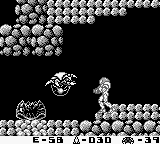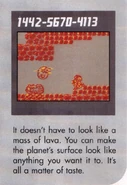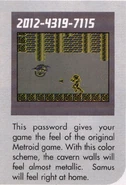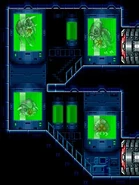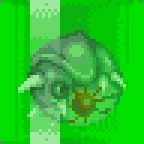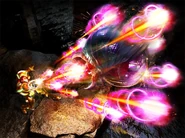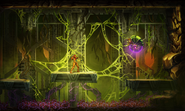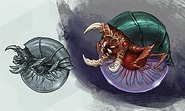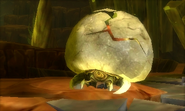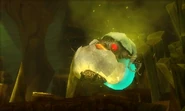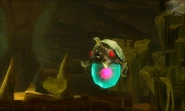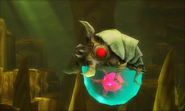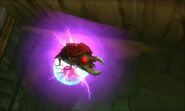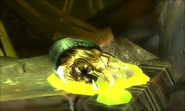| This is a featured article. |
The Alpha Metroid is the fourth stage of a typical Metroid's life cycle, appearing in three games, Metroid II: Return of Samus, Metroid Fusion and Metroid: Samus Returns, though they are a merely a cameo in Fusion.
The creature's insect-like appearance is a large departure from its prior and well-known larval stage. This metamorphosis will only occur if a Metroid larva is inhabiting its homeworld of SR388, or a replica of it. From this stage onward in the species' life cycle, a Metroid can no longer be immobilized with the Ice Beam, but can now be damaged and eventually killed with either Missiles or said beam. After an unknown period of time, the Alpha Metroid grows into a Gamma Metroid.
In Metroid II: Return of Samus, Samus Aran encountered fifteen Alpha Metroids during her mission to SR388, while in Metroid: Samus Returns there are seventeen Alphas.
Physiology
An Alpha Metroid molts from the topside of a Metroid larva's translucent membrane and leaves behind a shed husk in the process. The development has granted it new physical features: two red compound eyes, three large fangs surrounding a leech-like mouth outlined with smaller teeth, four budding limbs and a plated exoskeleton growing along the dorsal region. The Metroid now resembles an arthropod, and the species' characteristic membrane and red nucleus are now located on its underbelly. Due to unknown factors related to SR388's environment, a rare mutation can occur in which an Alpha Metroid is covered in a green, moss-like substance while possessing an additional pair of eyes.
The appearance of Alpha Metroids differed in Metroid II and Metroid Fusion; they lacked an oral cavity, therefore their three fangs functioned more as a central horn and two tusks. The compound eyes were initially of a blue color, and there were no mutated Alpha Metroids to be found.
Membrane and nucleus
Metroid larvae have four nuclei housed within their massive membranes, though they seemingly lose three of these when they become Alpha Metroids, as the latter possess only a single nucleus in their smaller membranes. Due to the fact that a larva leaves an empty membrane behind when it metamorphoses into an Alpha Metroid, it can be logically assumed that the three missing nuclei were re-purposed into creating the organism's new body in a fashion similar to an embryo's stem cells. The remaining nucleus is carried by the Metroid for the rest of its life cycle.
These anatomical changes have an impact on how the Metroid reacts to its species' major weakness: the Ice Beam. Contrary to a larva whose entire body is frozen solid when fired upon from any angle with the weapon's standard shot, an Alpha Metroid cannot be immobilized by any means. Only its membrane can be encased in ice, which will merely slow the creature's movement and is achievable strictly by shooting its membrane with a charged shot of the Ice Beam. The inability to completely freeze its body results from the newly-developed exoskeleton that borders the membrane; the small surface area of the membrane that remains exposed, along with the Metroid's unceasing movements as well as the delay in shooting consecutive charged shots, forces Samus to make accurate shots in the heat of battle.
However, an Alpha Metroid's membrane is frail, as it can be readily damaged with either concussive weaponry or the Ice Beam alone, unlike the Metroid larva's complete invulnerability to weapons unless it is specifically shot with missiles after it is frozen first. In addition, the membrane of the older Metroid remains frozen for a longer period of time than the younger form who unfreezes rapidly. This disparity in the membranes' defensive strength is likely determined by the number of nuclei present on their bodies.
The Alpha Metroid is arguably the weakest stage in the SR388 life cycle after the Infant Metroid. Nevertheless, it is the first crucial metamorphosis that will ultimately allow the creature to reach far superior forms, with many of the weaknesses listed above either diminished or removed entirely.
Behavior
In Return of Samus, the Alpha Metroid has very basic and straightforward movements, so it does not pose any large threat. It is impervious to all beam weaponry (including the Ice Beam, unlike in the game's remake) and can only be harmed by Missiles, of which five will take this creature down. Its only means of attack is ramming, as it lacks the life energy drain of its predecessor.
The Alpha Metroids can perform new attacks in Samus Returns, including attempting to dive-bomb Samus. When preparing this attack, they protect their vulnerable membrane by positioning themselves with their dorsal shell. The attack itself, however, can be parried with her Melee Counter and leave it open for damage. The Alpha Metroids will occasionally protect themselves by deploying a thin layer of electricity (or red plasma energy if dealing with the mutated variants) during their ramming maneuvers, neutralizing all of Samus' attacks (including the Melee Counter) except the Ice Beam. The normal variant can drop from its membrane small electrical spheres which detonate with a small radius; these can be destroyed for pickups. The mutant variety will instead drop large red indestructible plasma spheres that spread out into flames, covering the entire floor or platform it impacts on. These electric and plasma based traits are a precursor to the Gamma Metroid variants which possess extensive control over the elements.
Alpha Metroids are more durable in Samus Returns; the first one encountered takes 7 missiles to kill, and subsequent Alphas can withstand up to 15 missiles, with the mutated variant requiring additional hits. However, it can now be damaged by the Ice Beam or the Beam Burst. Their high mobility and aggression can make it difficult for Samus to score direct shots with her missiles, but a charged Ice Beam shot into the membrane will greatly hinder their speed and facilitate the next few shots. In addition, encasing their weak spot in ice will prevent the Metroids from deploying their energy barriers and force them to resort to their standard ram, giving Samus an opportunity to Melee Counter. If Missile ammunition is depleted, she can use her Ice Beam to damage the organisms, though it will take more time to finish them off. If a charged Ice Beam shot intersects with an electrical sphere and then proceeds to hit the Metroid, it will do substantially more damage. The more electrical spheres the shot passes through before hitting the Metroid, the more damage is dealt.
In Samus Returns, the first Metroid that Samus encounters is a larva that has recently drained a green Hornoad of its life energy. As she approaches it, the Metroid sheds its membrane and emerges as an Alpha Metroid, beginning the battle. As this Metroid had just metamorphosed, it lacks the ability to emit electricity or plasma.
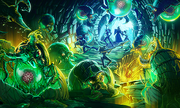
Metroids evolving into Alpha Metroids and turning on the Chozo
In image 8 of the Chozo Memories, the once-tame Metroid larvae created by the Chozo to combat the X Parasites were shown shedding their bodies, emerging as Alpha Metroids and turning against their creators. This implies that the Metroids' life cycle on SR388 was either an unintentional trait or the Chozo simply overestimated their ability to control the species as they molted into superior forms. As a result of the Metroids growing out of control, the Chozo brought about the creation and/or release of the purple liquid, alongside the construction of the Chozo Seals which were designed to contain the majority of the Metroid population deep underground.
Official Data
Metroid II: Return of Samus Manual
"This the shape of a Metroid after its first molting."
Virtual Console Manual
- Metroids (p. 16)
- Alpha Metroid
- "This Metroid has gone through its first molting."
Metroid: Samus Returns Official Guide
- Alpha Metroid (p. 21)
- "While Alpha Metroids may be the first “true” evolutionary form of the Metroid family, they’re not as frightening as most Metroids you run into. We label this stage the “awkward teenage years” of the Metroid maturity chain. They feature more attacks than your standard Metroid larva, but their growing carapace means they’re much slower and less aggressive than their younger cousins. They do receive a boost in defensive ability, so the Ice Beam-and-missile trick is no longer viable. That doesn’t mean they’re immune to these weapons, not by a long shot. However, don’t expect to dispatch an Alpha as quickly as you would a Metroid larva. With Alphas and all following Metroid evolutions, you’ve gotta work for your fights."
Trivia
- In Return of Samus, the Alpha Metroids shared their battle theme with all Metroids except the larvae and Queen. In Samus Returns, the Alpha Metroid gains two unique themes, and they are the only Metroid in the game to have multiple battle themes.
- Mochtroids, which are defective clones of Metroids created by Space Pirates, also possess a single nucleus. Contrary to the Alpha Metroid's and all subsequent stages of its life cycle, the organ is underdeveloped and very small.
- In the NTSC version of Metroid Prime, there are two Tallon Metroids designated as Metroid: Alpha Type, despite neither not having any close relation to an actual Alpha Metroid.
- The Alpha Metroid is the only stage whose metamorphosis process can be directly witnessed in the remake.



